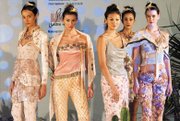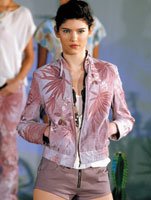Hong Kong Fashion Week Opens With Curtailed Business Following SARS Epidemic
The World Health Organization lifted the travel restrictions to Hong Kong two weeks before the opening of Hong Kong Fashion Week—but despite just a slight drop in attendance, exhibitors said the SARS epidemic diminished the amount of business done at the show.
The event, held July 8–11 at the Hong Kong Convention and Exhibition Centre, was the first trade show to take place in Hong Kong after the WHO lifted its travel restrictions to the former British colony on June 23. The region had more than 280 deaths due to SARS.
Officials from the Hong Kong Trade Development Council, which organizes Hong Kong Fashion Week, said there was only a 10 percent drop in visitors to the four-day show this year compared with last year.
“We had 12,858 visitors this year, compared with 14,291 last year,” said Katherine Chan, assistant communications manager for Hong Kong Fashion Week.
However, there was a more than 50 percent drop in attendance by overseas buyers. Only 2,000 overseas buyers showed up for the Spring/Summer 2004 show, compared with 5,818 last year.
Exhibitor numbers were off slightly, too. Last year, 540 exhibitors made it to the show, but that number dropped to 517 this year.
While attendance at the show was relatively robust, exhibitors said orders were dismal.
“The result was bad,” noted Alan Luk, of MY Garment Co., a Hong Kong knitwear manufacturer that exports mainly to Germany, Norway, Turkey, Australia and Thailand. “There was a lack of U.S. and European buyers. Only Chinese tourists came to shop around or to copy our styles. They have no interest in placing orders with you.”
Ocean Fashion Limited, a Hong Kong manufacturer, said its orders declined 30 percent from last year.
Executives from Renaissance Creations, a knitwear manufacturer in Tirupur, India, said the show was well-organized but business was atrocious.
“Genuine buyers were hard to find, and hardly any worthwhile business transactions happened,” commented Jayakumar Chinnaswamy, the company’s chief executive. “The previous shows were fine and had a pretty good number of buyers transacting business.”
There was some business to be had, but it was limited, according to Narinder Pal Singh, chairman and managing director of Nancy Krafts Ltd., a clothing manufacturer in India.
“No doubt we did business with some Chinese buyers,” he said, “But the dreaded SARS effect was there, and business was not.”
Show organizers, however, were pleased with the turnout. They had expected the show to be a disaster after SARS kept visitors away between March and June.
“Overall, we were satisfied with the result,” Chan said. “It was better than expected.”
The shortage of overseas visitors, however, put a crimp in the fashion-show schedule. Last year, Hong Kong Fashion Week organized six fashion shows. Organizers said this year there were only three because many overseas designers preferred to stay home until the SARS epidemic subsided.
Hong Kong has been relatively free of SARS since the end of May.
Hong Kong Fashion Week is held twice a year, in January and July. The January show, which typically draws more attendees and exhibitors than the summer event, is scheduled for Jan. 13–16, 2004.























